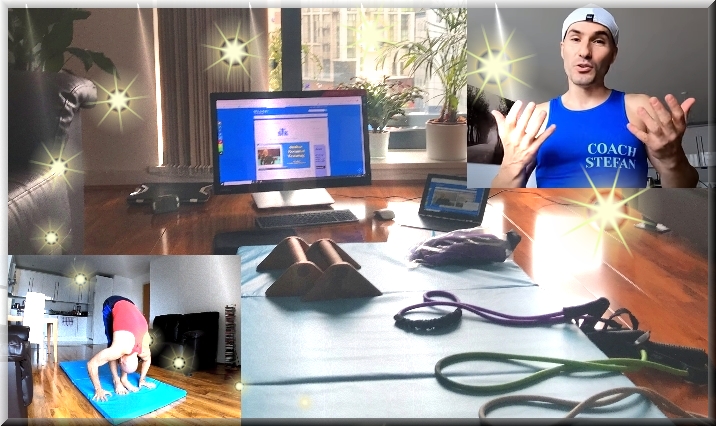How to Train for Gymnastics at Home: Tips and Tools
Gymnastics is a demanding sport that requires strength, flexibility, balance, and coordination. While training at a professional gym with access to various equipment and coaches is ideal, it’s also possible to make significant progress by training at home.
This guide provides a comprehensive approach to effective home training for gymnastics, ensuring that you have the right techniques, tools, and mindset to succeed.
Setting Up Your Home Gymnastics Space

Choosing the Right Area
Creating a dedicated space for gymnastics training is essential for safety and effectiveness. Select an area in your home with enough room to move freely without hitting obstacles.
A living room, basement, or even a backyard can serve as an excellent training spot. Ensure the floor is even and, if possible, free of clutter.
Investing in Basic Equipment
While advanced gymnastics equipment can be costly, you can start with some basic, affordable items that will significantly enhance your training:
- Gymnastics Mats: A good quality mat is crucial for practicing floor exercises and landings. Look for mats that provide adequate cushioning and support.
- Balance Beam: A low balance beam or a foam beam is ideal for practicing balance and coordination without the risk of high falls.
- Pull-Up Bar: Useful for building upper body strength, which is essential for various gymnastics skills.
- Resistance Bands: Great for strength training and flexibility exercises.
- Foam Rollers: Help with muscle recovery and flexibility improvement.
Developing a Training Routine
Warm-Up and Flexibility
A proper warm-up is crucial to prevent injuries and prepare your body for intense exercise. Start with 10-15 minutes of light cardio, such as jogging in place or jumping jacks, followed by dynamic stretches. Focus on areas that are particularly important for gymnastics, such as the shoulders, hips, and legs.
Flexibility is key in gymnastics. Spend at least 15-20 minutes daily on static and dynamic stretches. Incorporate stretches like the splits, pike stretches, and shoulder stretches to improve your range of motion.
Strength Training
Strength is a fundamental component of gymnastics. Focus on bodyweight exercises that target the core, upper body, and lower body.
Include exercises such as:
- Push-Ups: Great for building upper body strength.
- Planks: Essential for core stability.
- Squats and Lunges: Strengthen the legs and improve balance.
- Pull-Ups: Enhance upper body and grip strength.
- Leg Raises: Strengthen the core and hip flexors.
Aim for three sets of each exercise, with repetitions that challenge you but allow for proper form. Gradually increase the intensity and volume as your strength improves.
Skill Practice
Skill practice is where you apply your strength and flexibility to specific gymnastics movements.
Start with basic skills and gradually progress to more advanced ones as you build confidence and ability.
- Handstands: Practice against a wall initially for support, focusing on proper form and balance.
- Cartwheels: Begin with a lunge, kick over, and ensure a smooth landing.
- Round-Offs: Progress from cartwheels, adding a powerful push-off with both feet.
- Walkovers: Practice both front and back walkovers to improve flexibility and control.
- Jumps and Leaps: Work on height and form in your jumps and leaps, crucial for floor routines.
Consistency is key. Dedicate specific days of the week to different skills, ensuring a balanced approach that covers all aspects of gymnastics.
Staying Motivated and Safe
Setting Goals
Setting clear, achievable goals can keep you motivated and focused. Break down larger goals into smaller milestones.
For example, if your goal is to master a back handspring, start with goals like improving your handstand form, building shoulder strength, and practicing the motion with a spotter.
Tracking Progress
Keep a training journal to log your daily workouts, skills practiced, and any improvements. Video recordings of your practice sessions can also be beneficial for self-analysis and tracking progress over time.
Safety Considerations
Safety should always be a priority. Ensure you’re practicing on a stable surface and using mats to cushion falls.
If attempting new or complex skills, consider having a spotter or coach (virtually or in person) to guide you. Never push through pain or discomfort; listen to your body and allow adequate rest and recovery.
Leveraging Online Resources
Virtual Coaching
 With advancements in technology, access to professional coaching is now more accessible. Many coaches offer virtual training sessions and personalized feedback through video analysis. Utilize these services to get expert guidance and tailored training plans.
With advancements in technology, access to professional coaching is now more accessible. Many coaches offer virtual training sessions and personalized feedback through video analysis. Utilize these services to get expert guidance and tailored training plans.
Online Tutorials and Communities
There are numerous online resources available for gymnasts at all levels. Websites, YouTube channels, and social media platforms offer tutorials on various skills, conditioning exercises, and flexibility routines. Joining online communities can provide support, motivation, and valuable tips from fellow gymnasts.
Apps and Software
Consider using apps designed for gymnastics training. These can offer structured workout plans, skill tracking, and progress monitoring. Some apps even provide augmented reality features to help you visualize and perfect your form.
Conclusion
Training for gymnastics at home requires dedication, proper planning, and the right resources. By creating a suitable training environment, developing a balanced routine, staying motivated, and leveraging online tools, you can make significant progress in your gymnastics journey. Remember, consistency and patience are key. Celebrate your achievements, no matter how small, and enjoy the process of becoming a stronger, more skilled gymnast.

























